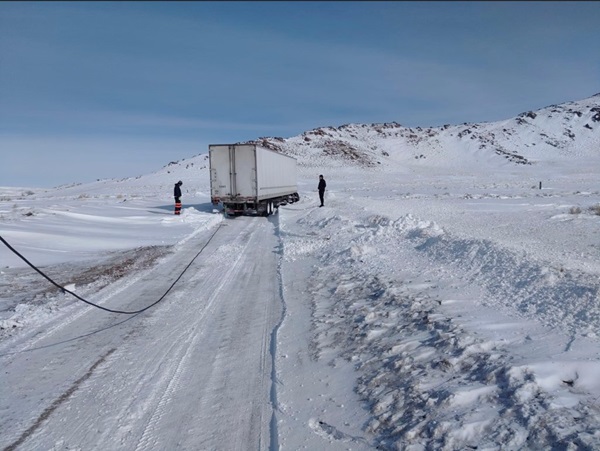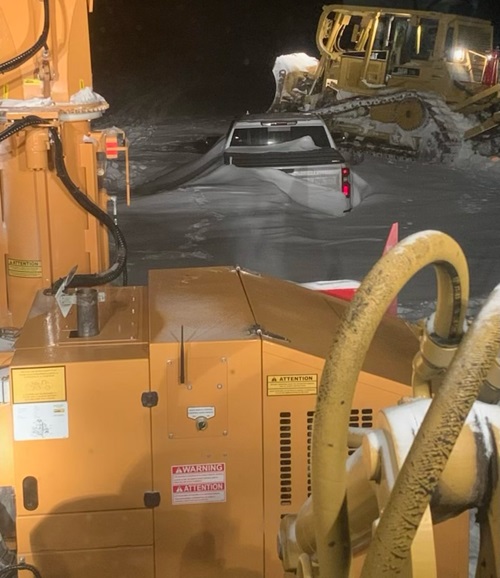In the winter months of some colder climate geographies, it is common for highways to close due to hazardous road conditions. When highways close, travelers turn to global positioning system (GPS) tools to find alternative routes to their destinations. Often, the GPS will stitch together a series of local roads to navigate drivers around the highway closure. However, many local roads suggested by GPS tools are not fully maintained in the winter months, directing drivers into potentially dangerous detours.
Wyoming is no stranger to this phenomenon as the region is gripped by winter weather for nearly half of the year and the region’s strong winds cause drifts and whiteouts that can make winter driving a challenging experience. The Wyoming Department of Transportation (WYDOT) is on a mission to resolve problematic GPS re-routes and is developing connected vehicle (CV) technology and traveler information messages (TIMs) to help keep drivers safe.
Winter road closures combined with GPS reliance can be a hazardous combination
In the first six weeks of 2023, Wyoming recorded 20 traffic fatalities, a 400% increase compared to the same period last year. During a 10-day stretch from the end of January to the beginning of February, the Wyoming Highway Patrol (WHP) received over 1,000 calls from stranded drivers. Many of the calls were from drivers who, attempting to get around a highway closure, had followed an alternative route provided by their chosen GPS tool.
The shortcomings of GPS tools’ access to real-time road conditions
Using machine learning, GPS tools process location information collected from users and historical traffic patterns to provide routes with the shortest travel time. Thanks to the advantages of machine learning, GPS tools grow more accurate every day. Still, GPS tools are often missing information about real-time road conditions. For example, the GPS tool may not understand which local roads have low snowplow priority. Following GPS tool recommendations, numerous drivers have found themselves stuck on impassable local roads and in potentially dangerous conditions.

Photo Courtesy WYDOT: Two individuals help pull a stranded tractor trailer from deep snow.
How Wyoming is solving the problem: Cascading road closures + TIMs
WYDOT is taking a two-prong approach to prevent drivers from using local roads as alternative routes for closed highways. The first part of the solution involves implementing cascading road closures. WYDOT is engaging with local counties to identify the network of local roads that need to be closed when a highway closure occurs. WYDOT is then incorporating that information in its central mapping systems so that when a highway closes, the corresponding local roads will appear as closed on the map to prevent drivers from using them.
The second part of the solution involves communicating the information about cascading road closures to as many drivers as possible. WYDOT uses several methods to communicate with drivers, such as dynamic message signs, local radio, the 511 website, and through the Traveler Information Skill within the Alexa assistant. However, out-of-state drivers are not always aware of these local resources and rely heavily on GPS tools.
Therefore, WYDOT is planning to leverage an existing CV system that distributes TIMs to third parties, like GPS providers, through a platform known as the Situation Data Exchange (SDX)®. Using SDX, WYDOT will be able to push information about cascading road closures to GPS providers. Then, when a driver’s GPS tool reroutes them because of a highway closure, the GPS tool will understand which local roads should also be avoided and will be able to communicate a safer route to the driver.
The bigger picture: Safer roadways everywhere
WYDOT’s future-forward approach to improving winter driving experiences serves as just one example of how CV technology can make roadways safer. The initiative could be expanded to
other states, especially those that face weather challenges similar to Wyoming. CV technology use cases like this could also prove useful in states prone to other events that impact roadways like wildfires, flash fog, and dust storms.
 Photo Courtesy WYDOT: Heavy machinery works to unbury a pickup truck stuck in deep snow.
Photo Courtesy WYDOT: Heavy machinery works to unbury a pickup truck stuck in deep snow.
Interested in learning more?
Connect with our Technology Services & Solutions Team to learn more about how CV technology, like the SDX, can be applied to roadway safety challenges in your state.
Upcoming training
- April 12, 2023: Free 1-hour webinar offering insights into overcoming common CV technology deployment challenges.
